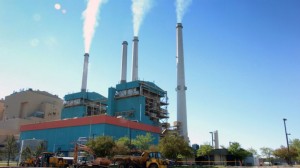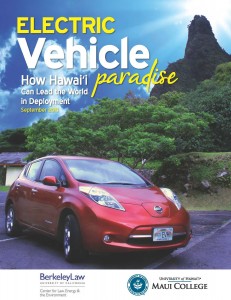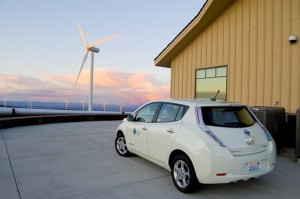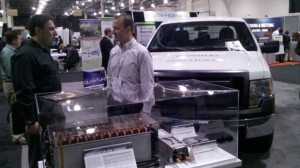 It seems counter-intuitive, but that’s what hot tub dealers like to say. They may have a point: after a long soak, the shower that follows will probably be quicker because you don’t need the warm water to warm you up in the cold winter months. And the water that gets dumped every six months or so can be used to irrigate nearby plants (provided the chlorine levels have dropped enough, if you don’t use bromine to keep it clean). And if you take regular baths, hot tubs are a much better substitute from a water conservation standpoint.
It seems counter-intuitive, but that’s what hot tub dealers like to say. They may have a point: after a long soak, the shower that follows will probably be quicker because you don’t need the warm water to warm you up in the cold winter months. And the water that gets dumped every six months or so can be used to irrigate nearby plants (provided the chlorine levels have dropped enough, if you don’t use bromine to keep it clean). And if you take regular baths, hot tubs are a much better substitute from a water conservation standpoint.
But when droughts hit, severe water rationing usually means that hot tub owners are encouraged not to fill their tubs (as happened in Santa Cruz recently). So if hot tub dealers feel the data are on their side in terms of water conservation benefits, they should study this issue to change policy decision-making.
In general though, hot tubs are an environmental negative due to the energy required to heat the tubs. Of course, if you have solar panels or live in some kind of eco-compound in the Rockies like Amory Lovins, then maybe you can be forgiven for indulging in warm water.
Either way, I’m up for doing a significant amount of research on this topic.
It’s commonly accepted that millennials (those born between 1983 and 2000) are driving less than previous generations, contributing to a multiyear drop in per capita vehicle miles traveled in the US. But why exactly are they driving less? And will the trend hold as they age? The answers carry huge policy implications, particularly for our transportation and land use decision-making. Both processes put in place infrastructure designed to last decades.
Emily Badger at the Washington Post tackles this question. Her basic conclusion is that it’s likely a mix of factors, from a down economy to the rise of technology (mainly smart phones) to a cultural shift about cars. And of course, more study will be needed to see how permanent the shifts are over time.
One interesting economic factor she cites is that the high cost of living may force millennials to cut back on transportation expenses. So could our restrictive local housing policies actually be creating a culture that demands more urban housing? There’s some irony in that outcome, if that’s the case.
While we have to take a wait-and-see attitude, one finding is already clear to have long-lasting import: millennials simply don’t identify cars with status like previous generations. Their whole attitude about driving seems markedly different, since they’ve never known cheap gas and only know traffic.
Policy makers should certainly take note of this cultural and generational shift — and design our urban spaces and transportation infrastructure accordingly.
 The (aptly named) Union of Concerned Scientists released a report this week showing that the U.S. Environmental Protection Agency’s new power plant rule sets a national renewable energy target that is barely above federal business-as-usual projections.
The (aptly named) Union of Concerned Scientists released a report this week showing that the U.S. Environmental Protection Agency’s new power plant rule sets a national renewable energy target that is barely above federal business-as-usual projections.
This rule was supposed to be one of the Obama Administration’s signature climate change achievements, issued under the Clean Air Act pursuant to a 2007 Supreme Court decision requiring it. So what gives? As one of the study researchers commented:
“The EPA was obviously feeling pressure from Congress and states over the rule and wanted to come up with something they thought would be defensible,” Steve Clemmer, director of energy research at UCS, told ThinkProgress. “I think they ended up erring too far on the side of being conservative about renewables. When the EIA — not an agency that’s seen as being optimistic about renewables — says we’re going to pretty much get to that level without the Clean Power Plan, that’s pretty pessimistic and unrealistic really.”
Given that the rule is still in draft stage, there is time to improve it. The study authors recommend that EPA bump up the renewable goal considerably, noting that states can cost-effectively produce nearly twice as much renewable electricity as the agency calculated. And it’s worth keeping in mind that the renewable energy target is only one part of the rule, which also includes energy efficiency and other greenhouse gas-reducing measures.
Given the environmental weakness of this part of EPA’s draft regulation, it’s ironic that congressional Republicans are complaining that EPA worked too closely with environmentalists in crafting it. For my part, I certainly hope EPA will be more receptive to input on this issue from the environmental community going forward.
The UCLA/Berkeley Law webinar on repurposing electric vehicle batteries for grid storage is now on-line. The September 19th event discusses key recommendations from the new report “Reuse and Repower” and features Adam Langton, Senior Energy Analyst at the California Public Utilities Commission, and Randall Winston, Special Assistant to the Executive Secretary in the Office of Governor Brown.
You can watch the one-hour video here or below:
Electric vehicles in Hawaii should be a no-brainer. The limited island geographies make battery “range anxiety” either easy to solve through a few public charging stations or practically non-existent. The high gas prices make driving economically painful. And the abundant renewable energy there (solar, wind, and geothermal) means lot of potential for cheap, clean electricity.
But the U.S. Department of Energy “eGallon” website shows a critical disconnect. In most states, the equivalent “miles per gallon” of using electricity instead of gas for driving results in huge savings. The average U.S. gallon of gas costs $3.52, while the equivalent cost in electricity is $1.27. Pretty nice amount of savings, no?
 Well, in Hawaii, we have an outlier result. The extremely high cost of electricity (most is generated from burning imported diesel), coupled with the high cost of gas, results in an unfortunate comparison: $3.79 for a gallon of gas vs. $3.75 in equivalent electricity costs. So you’ll save 4 cents per gallon going electric! Pretty weak.
Well, in Hawaii, we have an outlier result. The extremely high cost of electricity (most is generated from burning imported diesel), coupled with the high cost of gas, results in an unfortunate comparison: $3.79 for a gallon of gas vs. $3.75 in equivalent electricity costs. So you’ll save 4 cents per gallon going electric! Pretty weak.
That’s where rooftop solar comes into play. For residents of Hawaii with these systems, they can pay almost nothing in electricity through the state’s net metering program. This arrangement makes the savings from going electric probably greater than in almost any other state. In fact, in researching the report “Electric Vehicle Paradise” for Berkeley Law and Maui College last year, almost everyone I talked to who had purchased or leased an EV in the islands had rooftop solar. And they were motivated to go electric because they were producing too much solar from their roof.
That’s why our report recommended that Hawaii’s utilities, especially Hawaiian Electric (HECO), remove barriers to installing rooftop solar. At the time, the utility privately claimed to me that they really didn’t have any barriers, such as expensive interconnection studies. But shortly after we released the report they began clamping down aggressively on rooftop arrays with these studies.
But change is in the works. In response to an aggressive state public utilities commission directive, HECO now plans to go 65% renewable by 2030, which is great. But the utility wants to impose a fixed monthly charge of $55 on solar customers, which could undermine the economics of going solar. And HECO still needs to get rid of phony “interconnection studies” that can cost thousands of dollars for a property owner trying to install solar.
With rooftop solar, particularly in Hawaii, it’s not just about cleaning the electricity system — it’s about driving cleaner, too. Not to mention that more EVs ultimately boosts energy storage in the islands from repurposed electric vehicle batteries. So let’s hope HECO does the right thing, because the whole movement to a cleaner, cheaper energy system in Hawaii starts with solar.
Sometimes I get that feeling that the pro-transit (or pro-walking/biking) crowd is uneasy about the subject of electric vehicles, if downright negative. Why? Many transit advocates don’t like cars — viewing them as dangerous to bikers and pedestrians (which they are). They also don’t like how cars chew up the environment and create terrible traffic and isolation.
Not only that, but electric vehicles are frequently cited by transit critics as a reason to continue business-as-usual development patterns, in which we continue to build communities around cars, as opposed to walking- and biking-friendly communities oriented to transit. After all, if we’re moving toward electric and other clean vehicles, who cares any more about the pollution and negative public health effects from sprawl?
Certainly the advent of electric vehicles undercuts a key argument in favor of transit and more human-centered communities. It’s true that electric vehicles, if we can get there fast enough, will solve much of the pollution and public health challenges from sprawl. But it will take decades (most likely) to fully transform our existing fleet of cars to electric, as the technology is not fully developed and at this point not appropriate for all types of vehicle usage. So the public health and pollution problems from unabated sprawl will continue. But the writing, I believe, is on the wall for a cleaner transportation system.
So where does that leave public transit advocates in the long term? Well, we have to remember that the arguments against sprawl and in favor of more convenient, connected communities oriented around transit are not just limited to reducing pollution. Traffic is a miserable economic drag on our economy and quality of life. Biking and walking is fun and good for you, and it leads to communities with more social interaction, particularly for children, the elderly, and those who can’t or won’t drive. California’s severe housing shortage and changing patterns of demand argue in favor of building as many homes and jobs as we can around transit. And sprawl continues to eat up our valuable farm land and open space, as well as sensitive ecological areas.
I’m certainly in both camps. I love transit, use it every day, and walk and bike as much as possible. But I also see the need for electric vehicles. Not everyone can rely on non-vehicle forms of mobility for all their needs. Cars are here to stay. So we need to transition our fleets to clean vehicles. We also need to invest in battery technologies as a crucial way to decarbonize the electricity grid. Plus, electric vehicles are fun to drive (this from someone who never cared about cars or driving before).
Ultimately we’ll need both technologies going forward, and I don’t think anyone should hesitate to advocate for both.
 The United Kingdom has been a leader on encouraging building owners to upgrade the energy performance of their properties. The country mandates disclosure of building energy performance during sale or lease to make new owners aware of the inefficiencies. And it launched the “Green Deal” program in 2013:
The United Kingdom has been a leader on encouraging building owners to upgrade the energy performance of their properties. The country mandates disclosure of building energy performance during sale or lease to make new owners aware of the inefficiencies. And it launched the “Green Deal” program in 2013:
The scheme aimed to encourage millions of households to take out loans to fund the cost of work such as installing insulation or new boilers, with the loans paid back in instalments on their energy bills. It was marketed around the idea that the household would end up better off, because the repayments would be lower than savings the household enjoyed from being more energy efficient.
But things didn’t go as planned:
[I]t has been beset by problems from the outset, with high interest rates on loans widely regarded as unattractive, and ministers forced to admit that savings were not guaranteed. Fewer than 4,000 households had signed up for ‘Green Deals’ by the end of July.
The troubles with the UK program mirror the challenges that California has faced with its Energy Upgrade program:
According to an analysis of state data by the San Francisco Chronicle, California has only supported 12,200 home efficiency retrofits under its Energy Upgrade California program since 2011. The stated goal of the program is to service over 100,000 homes.
The culprit in California is the complex administrative process to qualify for the rebates and incentives. I know from personal experience. When I tried to access the financial incentives from Energy Upgrade California when I wanted to add insulation to my attic, the program required an expensive energy audit both before and after, even though I had already had an audit done the calendar year before. So I just skipped the audit and the incentives entirely but still got the work done.
Cracking this nut is difficult. Each building is different, and even though the savings are potentially significant, many property owners don’t want to deal with the hassle or expense of an upgrade to the building. Maybe California and the UK can learn from each other, because we’re definitely going to need to make the process and incentives as seamless as possible to encourage people to undertake these upgrades.
Some good laws are now in effect on both rooftop solar and electric vehicles in California. I blogged about AB 2188 once it passed the California Legislature, which will require local governments to adopt streamlined ordinances for permitting rooftop solar. The governor signed it, which will be helpful for reducing the cost of installing solar, possibly up to 20 cents per watt.
 In addition, as I discussed on KCRW radio on Monday, the governor signed AB 2013 (Murastsuchi) to increase the number of “green stickers” available for partial electric/hybrid vehicles to access carpool lanes, as well as SB 1275 (De Leon) to limit cash rebates for electric vehicles based on income. The latter bill directs the California Air Resources Board to come up with an overall, long-term financial plan for supporting electric vehicles, taking into account anticipated price declines on the vehicles. That plan will likely include a phase-out for the rebates and may explore other options, such as point-of-sale cash rather than having to apply for the rebate after purchase.
In addition, as I discussed on KCRW radio on Monday, the governor signed AB 2013 (Murastsuchi) to increase the number of “green stickers” available for partial electric/hybrid vehicles to access carpool lanes, as well as SB 1275 (De Leon) to limit cash rebates for electric vehicles based on income. The latter bill directs the California Air Resources Board to come up with an overall, long-term financial plan for supporting electric vehicles, taking into account anticipated price declines on the vehicles. That plan will likely include a phase-out for the rebates and may explore other options, such as point-of-sale cash rather than having to apply for the rebate after purchase.
With these bills, California is continuing its leadership on renewables and electric vehicles, and hopefully making our public sector incentives more efficient and streamlined in the process. I’m glad the governor signed them, showing that we’re making incremental progress on these vital technologies.
Over the past two days, I attended the Battery Show conference outside of Detroit, Michigan, to hear what the leading entrepreneurs, researchers and automakers have to say about the state of electric vehicle batteries. While I was there to speak on a panel about a new report on repurposing electric vehicle batteries, I picked up some interesting themes about the most important clean technology out there, the battery. Here they are:
Carbon regulations & clean energy policies have been critical for pushing the battery market. Speaker after speaker spoke about the growing global policies on carbon, from California to the US EPA rule on power plants to Japan and China’s new emphasis on reducing pollution. Industry leaders estimate that the carbon regulations will result in a 4% per year rate of change in carbon emissions going forward. But the policies also include non-climate focused efforts, such as the new U.S. fuel economy standards. From 1975 to 2011, CAFE standards required only a 1.3% improvement per year on average, but from 2012 to 2025 they will require a 4.5% per year improvement, greatly benefiting clean vehicle technologies like EVs. And of course California’s leading policies on zero-emission vehicles and energy storage in general is providing a critical market foundation. One speaker said “we wouldn’t be here today talking about these issues without California’s leadership.”
 Lithium ion is still the most promising battery technology, with continued price reductions but no overnight breakthroughs. Speaker after speaker praised lithium ion as still the best battery technology out there, given its high energy density and low weight. Nobody foresees any other technology out there to rival it. In terms of cost and advances, it’s clear that costs will continue to decline, although not precipitously. By the end of this decade, most speakers believed Tesla will either achieve or come close to achieving the magic price/range of 200 miles per charge in a $35,000 EV. Improving manufacturing supply chains and automation will help tremendously, as the Tesla Gigafactory will be able to do.
Lithium ion is still the most promising battery technology, with continued price reductions but no overnight breakthroughs. Speaker after speaker praised lithium ion as still the best battery technology out there, given its high energy density and low weight. Nobody foresees any other technology out there to rival it. In terms of cost and advances, it’s clear that costs will continue to decline, although not precipitously. By the end of this decade, most speakers believed Tesla will either achieve or come close to achieving the magic price/range of 200 miles per charge in a $35,000 EV. Improving manufacturing supply chains and automation will help tremendously, as the Tesla Gigafactory will be able to do.
EV drivers want performance, not necessarily environmental benefits. Marketing and survey data clearly show that buyers concerned about fuel economy and environmental performance do not make up a huge percentage of the market. Instead, they want performance, style, and access to technology. Tesla has hit this magic formula well, as they downplay the environmental benefits of going electric. Perhaps Nissan should follow suit and rename the LEAF something less “green” sounding. After all, when I tell people what I like about my electric car, I always start with the superior performance of the electric drive, and then I finish by touting the fuel savings (which are huge) and the environmental benefits. I don’t do this strategically: it’s just the truth about what I’m most excited about with the car.
Repurposing batteries is a big open question, with lots of opportunities but lots of unknowns. Since it was the subject of my report, I was keen to hear people’s take on this topic. Many speakers who addressed the issue felt the potential is huge, noting the amount of energy storage available in electric vehicle batteries on the road today and in the near future. But many felt that these batteries would have to compete with the cost of recycling the batteries, which could become much cheaper through automation. And there are unknowns about how easy and cheap it will be to collect, verify, and stack the batteries for high-performance energy storage. But given the size of the opportunity and the environmental need, I encourage policy makers and industry to start analyzing the opportunities as thoroughly as possible, as outlined in the report.
Overall, it was a well-run conference that attracted an impressive group of speakers and leaders in the field. Cheap batteries will not only revolutionize transportation through electric vehicles, they will clean our grid when coupled with renewable resources. The solar+storage combo may also change the utility world forever: after all, who needs a utility if you and your neighbors can generate and store your own clean power? The disruption continues, while Michigan feels like a dream to me now.
On the heels of the new UC Berkeley/UCLA Law report on harvesting “second life” electric vehicle batteries, the Sacramento Bee is running an op-ed from me today on the topic. You can read it here. As I write in the piece, even with the Tesla Gigafactory going to Nevada,
California still has an opportunity to boost an entirely different battery supply market, one that will also help the state clean our energy supply and reduce the cost of electric vehicles in the process. The answer lies not in manufacturing new batteries, but repurposing used ones.
Let’s hope policy makers take note and take the steps necessary to boosting this new market.




